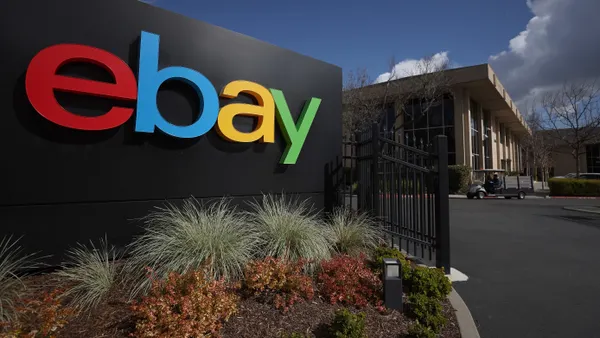Dive Brief:
-
Shopify, the e-commerce giant, reported revenue more than doubled to $988.6 million for the first quarter this year. Revenue generated from services for online merchants jumped 137% over the period last year to $668 million, the company reported during an earnings call.
-
Shopify gained market share with respect to total U.S. e-commerce sales to 8.6% in Q1 2021, compared to 5.9% in Q1 2020. Competitors eBay, Apple and Amazon lost e-commerce sales market share in the U.S., according to some estimates.
-
The Ottawa-based company expects a "normalized pace of growth" in 2021, as economies open up and some consumer spending returns to offline venues, Shopify's CFO Amy Shapero said during the earnings call.
Dive Insight:
As the pandemic pushed buyers towards e-commerce channels, platforms like Shopify enjoyed exponential growth. Shopify's net income for Q1 2021 was $1.2 billion, or $9.94 per diluted share, compared with a net loss of $31.4 million, or $0.27 per diluted share in Q1 2020. Its revenue increase 110% year-over-year, primarily driven by increased online sales.
"It's been more than a year since the global pandemic began, which triggered e-commerce to grow at a rate that has transformed the traditional retail model," Shopify President Harley Finkelstein said during the earnings call. "Merchant sales growth on our platform accelerated in the first quarter as merchants leveraged our modern commerce technology," Finkelstein said in another statement.
In 2020, e-commerce sales surged 32.4% annually to $749.5 billion annually. This growth was more than double the 2019 annual growth rate, as shuttered stores and consumers' wariness toward in-person interaction pushed them to shop online, according to a report by Intelligence Insider.
The company added merchants on its platform and saw gross merchandise volume (GMV) on its platform grow by 114% YoY to $37.3 billion in Q1 2021, an increase of $19.9 billion YoY. Shopify also experienced an increase in gross payment volume (GPV) on Shopify Payments, the payments platform where merchants can accept payments from customers. A majority of the merchants coming onto Shopify opted to use Shopify Payments, Shapero said during the earnings call.
"Strong Q1 GMV versus last year was the result of a greater share of retail spend going to online purchases," Shapero said. "$17.3 billion of GMV was processed on Shopify Payments in Q1, an increase of 135% versus the comparable quarter last year."
Shopify Capital has grown to approximately $2.0 billion in cumulative capital advanced since its launch in April 2016. Nearly $312.8 million of advances and loans were outstanding on March 31, 2021 compared to $192 million at March 31, 2020.
Shopify's investment in Affirm also paid off during the quarter when Affirm sold stock for the first time in a January initial public offering, and earned $1.3 billion in unrealized gains. Last year, Shopify launched Shopify Pay Installments where customers can pay merchants in four equal installments.
Shopify also partnered with TikTok to enable merchants to receive payments from their TikTok followers, exploring social commerce.
"We expanded our marketing partnership with TikTok internationally to an additional 14 countries in North America, EMEA, and APAC," Finkelstein said during the earnings call. "So far, we've seen good traction in the adoption of TikTok in the U.S. since we launched the integration last October."
The company also integrated its Shop Pay service on Facebook and Instagram to allow customers to buy and pay for products through social media channels.
"The number of shops actively selling on Facebook has more than quadrupled since Q1 a year ago, as well as the GMV through Facebook," Finkelstein said.
Since its incorporation in 2004, Shopify has operated the second largest e-commerce platform in the U.S., conducting nearly 8.6% of all e-commerce sales in the country. Amazon operates the largest e-commerce platform with over one-third of all e-commerce sales in the U.S, according to Shopify.
Last year, Amazon saw its grip on e-commerce loosen a bit as other platforms gained market share. According to DigitalCommerce360, a think tank, Amazon represented nearly 31.4% of all U.S. ecommerce sales growth in 2020.
"The 31.4% is down from Amazon's 43.8% share in 2019," DigitalCommerce360 stated. "This is likely a sign of the gains made by other big competitors in 2020."
E-commerce sales grew by 44% in 2020 offset by the pandemic. Shopify expects sales to flow back to in-store and physical retail channels as vaccine roll outs open up the economy.
"Some consumer spending will likely rotate back to offline retail and services, and the shift to e-commerce, which was accelerated in 2020, will likely resume a more normalized pace of growth," Shapero said.
The Canadian company has nearly 1.7 million merchants on its platform, according to its annual 'Economic Impact Report.' The report published together by Deloitte, calculated the economic impacts associated or generated by Shopify businesses using their services. Businesses using Shopify generated $307 billion in 2020 in revenue, compared to $136 billion in 2019 and employed 3.6 million full time in 2020, compared to 1.2 million 2019.













